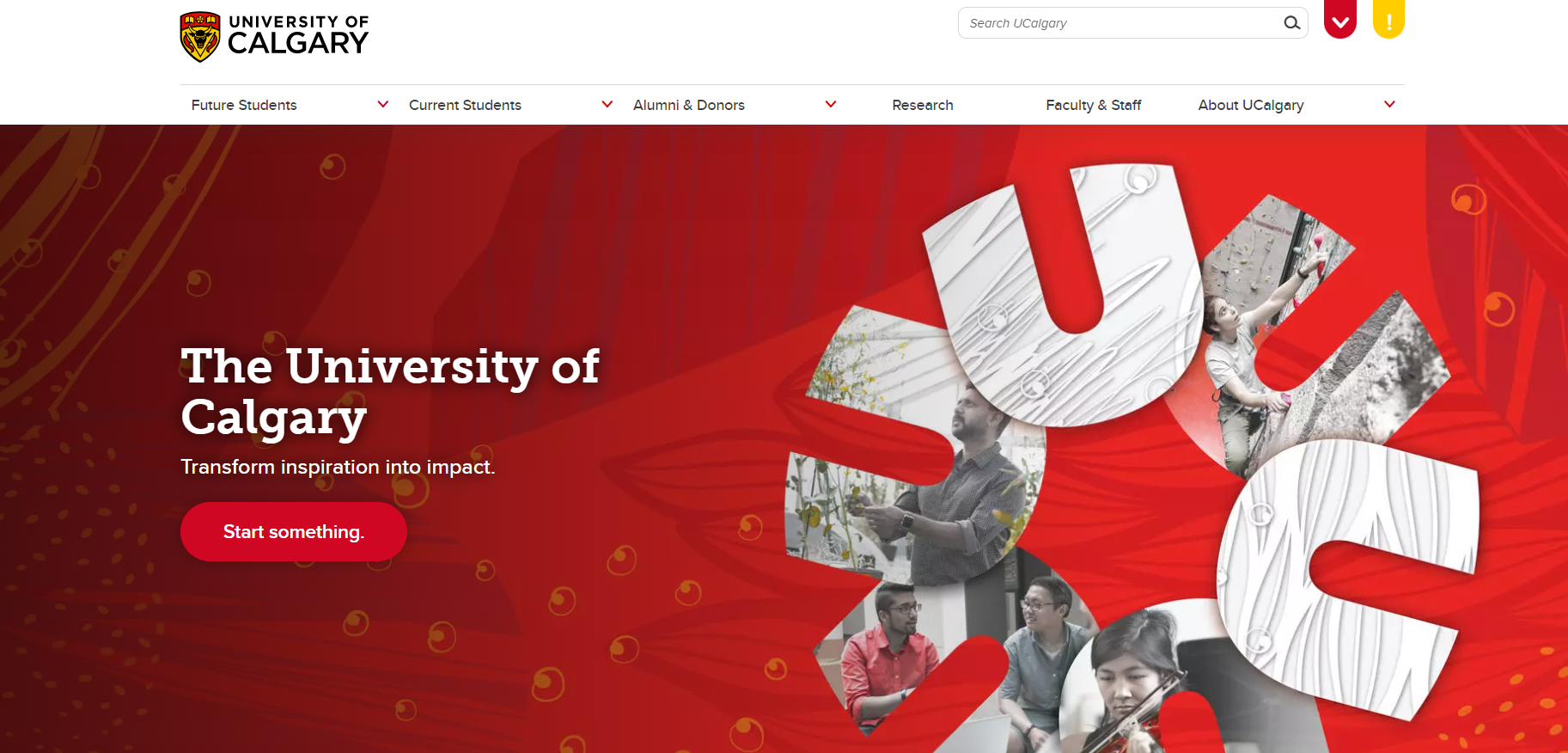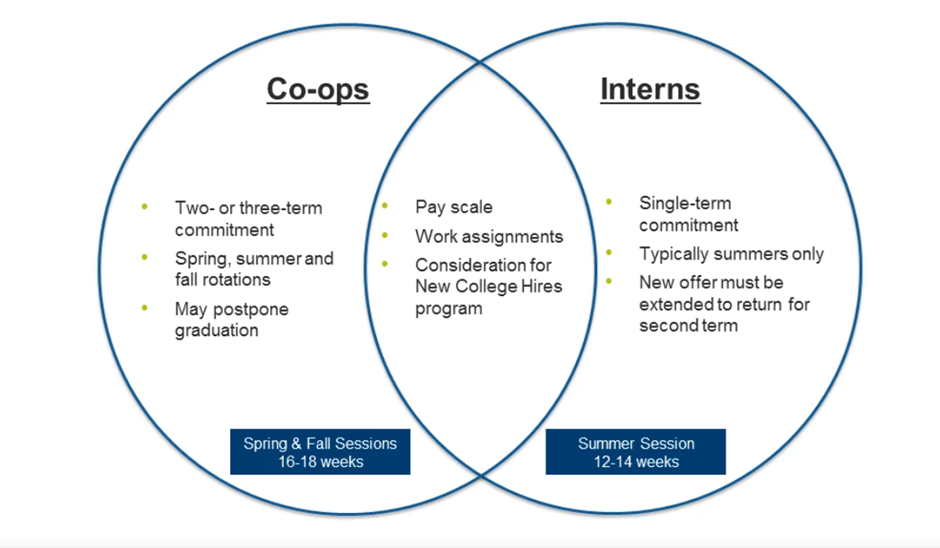Co-op programmes are a great way to gain real-world professional experience while still in college. Moreover, it allows you to explore different fields, financially support your education, and increase your probability of getting a job right out of college.
In this article, you’ll learn about co-op programmes, their pros and cons, top colleges for co-op programmes, etc.
What is Co-Op Education?
Also called co-operative education, it is a programme wherein you study and work in an actual industry or company in your field of education. The programme’s structure follows an alternating pattern where you study one semester and work the next. But unlike internships, you work as full-time employees with a full salary.
Venn diagram of co-op and internship programmes
How does it work?
First, you will require a work permit to pursue a co-op programme in Canada. Apply for it beforehand to avoid any last-minute inconvenience. Second, you should keep in mind that you cannot work for more than 50 percent of the programme duration.
As mentioned earlier, you will be alternating between work and academic terms. You will work full time like any other job during the work term.
You will implement everything you learned during the initial academic term in your work term. This unique experience allows you to gain work experience during your academic programme.
Remember that there’s a classroom full of people looking for co-op opportunities just like you. To beat the heat of competition during your work term, you have three ways to find good co-op opportunities in Canada.
- Network: Like in all spheres of life, communication is key to finding a good co-op position. Get in touch with your seniors and talk to them about your concerns. They might be able to recommend co-op employers that fit your needs. So, do not hesitate to ask them.
- Co-op Advisor: Your co-op advisor will support you in finding a co-op position. They will even notify you personally when a co-op position is suitable for your preferences.
- The Web: The internet is your best buddy for hunting for jobs. Surf the web to find online listings for co-op opportunities. Your university website and LinkedIn are great places to start.

You can use platforms like Indeed to look for co-op opportunities.
The Advantages and Disadvantages of Co-op Programmes
Co-op programmes are becoming increasingly popular recently.
According to HSBC, 70% of students joining the University of Waterloo enroll in the 120 co-op programmes the university offers. And 96 percent of these co-op programme graduates find a job within six months from graduation.
The Advantages
- Although not assured, you gain work experience while pursuing your degree programme. This gives you higher odds of landing a job right out of college.
- Since most colleges provide life skill training during the first term, you get a clear advantage over other college students. It includes various skills you would find useful to thrive in a professional environment.
- Since there are multiple work terms, you can explore numerous fields within your subject of study. This provides you with varied experience and a generalist reputation set in your field. You will also be able to identify your strong and weak links while working in various industries, giving you time to evaluate your future.
- The money you earn during your work term is a perk you can use to pay tuition fees or spend on yourself. Either way, you have a winning situation.
- During the work terms, you gain experience and a chance to grow your network. You work with people from numerous companies. Some of them could end up being your future officemates or employers. So, get networking as soon as you join a co-op programme.
The Disadvantages
- Co-op programmes, although versatile, can be hectic. You will have to look for a co-op position after every academic term. Along with the heavy competition from your classmates, it can be cumbersome.
- Although highly advantageous, co-op programmes are not that common. Only a few universities offer such programmes. Because the system is highly progressive, not many people are ready to adapt, and it can be a bit more expensive compared to regular degree programmes.
- Co-op programmes are generally longer than regular degrees. The work terms contribute to the extended length, and the duration also takes a toll on your finances. Longer programmes equal higher expenses.
Top Colleges Offering Co-op Programmes in Canada
Canada has the highest number of co-op courses worldwide. Universities utilize this progressive education system to provide a better and increasingly practical educational experience to all students.
Here’s a list of ten leading universities offering co-op courses in Canada,
1. Centennial College of Applied Arts and Technology

It’s a college in Toronto, Ontario, that grants degrees and diplomas. It is culturally diverse and represents almost 100 ethnocultural groups, with over 80 languages being spoken on the campus.
You can choose from full-time programmes in over 100 different fields. The programmes also emphasize lab instructions, co-op opportunities, and agency and industry placements.
2. Simon Fraser University
Simon Fraser University is a public research university in Canada’s British Columbia. It has 3 campuses, home to 30,000 students.
The university is a member of education associations like the International Association of Universities, Association of Commonwealth Universities, and Universities Canada.

3. University of Alberta
Founded in 1908, it’s a public research university in Edmonton, Alberta. The university has four campuses in Edmonton, ~40,000 students, 388 undergraduate programs, and 500 graduate programmes.
4. University of British Columbia
is a public research university with campuses in Vancouver and British Columbia. It is the oldest university in British Columbia and ranks in the top three in Canada.
The UBC Library is one of the largest research libraries in the country, and it holds more than 9.9 million volumes.
5. University of Calgary
It’s a public research university in Calgary, Alberta. It’s been autonomous since 1966, before which it was a branch of the University of Alberta. It holds ~30,000 students and has over 1,848 academic staff. The university has 250 programs to offer and hosts 14 faculties and 85 departments.

6. University of Ottawa
It’s a bilingual public research university located in Ottawa, Ontario. It was established in 1848.
The university is 41,749 students strong, with over 2,911 academic staff. It is the largest bilingual (French-English) university in the world. The university has exchange agreements with around 250 institutions in 52 countries.

7. University of Quebec
It is a system of public universities provincially run in Quebec, Canada. The university offers around 300 programs and hosts more than 87,000 students. Here’s a list of institutions that are a part of the university,

- The Université TÉLUQ, Quebec City
- The Université du Québec en Outaouais (UQO), Gatineau with a campus in Saint-Jérôme.
- The Université du Québec en Abitibi-Témiscamingue (UQAT), Rouyn-Noranda, Val-d’Or, etc.
- The Université du Québec à Trois-Rivières (UQTR), Trois-Rivières;
- The Université du Québec à Rimouski (UQAR), Rimouski;
- The Université du Québec à Montréal (UQAM), Montreal;
- The Université du Québec à Chicoutimi (UQAC), Saguenay;
- The Institut national de la recherche scientifique (INRS), Quebec City and Montreal;
- The École nationale d’administration publique (ENAP), based in Quebec City, Montreal, Gatineau, Trois-Rivières, and Saguenay;
- The École de technologie supérieure (ETS), Montreal
8. University of Victoria
It is a public research university in Oak Bay and Saanich, British Columbia. The QS World University Rankings gave the university 359th rank worldwide. The university holds over 21,696 students and 900 academic staff.

9. University of Waterloo
It is a public research university in Waterloo, Ontario. Also, the university operates the largest post-secondary co-op program with over 20,000 students. It is almost 50% compared to the university’s 40,513.

10. Wilfrid Laurier University
Commonly referred to as WLU or Laurier, it is a public research university that has campuses in Waterloo, Milton, and Brantford. The university has a student strength of over 18,000 students.

The above image contains a detailed breakdown of all costs related to co-op programmes in three different fields. You can use EduCanada’s website to calculate your cost of studying and living in Canada too. It is the Government of Canada’s official website for international students studying in Canada. Use the find programmes section to find your ideal programme and college.
Eligibility For Co-Op Programs
First and foremost, you will need admission into a co-op program. You can start applying for a study permit and co-op work permit once you receive your university acceptance letter. The criteria to obtain a co-op work permit are,
- Work should be a requirement to complete your academic programme
- You should possess a study permit
- Co-op placement should account for less than 50% of the total programme
Interestingly, you can also be ineligible for a co-op work permit if you,
- Are pursuing English or French as a second language
- Choose a general interest course
- Are pursuing a course or programme to prepare for a different academic programme
Advantages Of Pursuing A Co-Op Program In Canada (The International Student Version)
There is a list of advantages that are much more valuable for international students compared to students from Canada.
- You get paid like an employee and not an intern
- Getting a permanent job and settling in Canada is easier
- You get exposed to professional and international work experience even before you graduate
Applying for a Co-op Programme in Canada as a Student from India
The application process starts months before the programme commences. You can start submitting applications through official university websites. Here’s a list of points you’ll have to keep in mind during the application process,
- Before filling out applications, have all your documents ready. It includes your SOPs essays, LORs, certificates, and proof of scores from TOEFL, IELTS, GRE, GMAT, etc.
- Besides the university application, you should also start submitting applications for accommodation, a student visa, scholarships and student loans.
- Once you receive your acceptance letter, virtually get in touch with everyone related to your programme. This can be pretty helpful.
Canada attracts plenty of students from India every year. The country offers you high-quality education at an affordable cost. If you’re planning on pursuing your higher education in Canada, you better be prepared to handle its cold climate. All the best for your future pursuits.

















